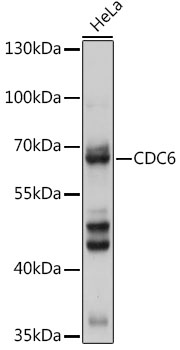Anti-CDC6 Antibody (CAB18249)
- SKU:
- CAB18249
- Product type:
- Antibody
- Reactivity:
- Human
- Host Species:
- Rabbit
- Isotype:
- IgG
- Research Area:
- Cell Cycle
Description
| Antibody Name: | Anti-CDC6 Antibody |
| Antibody SKU: | CAB18249 |
| Antibody Size: | 20uL, 50uL, 100uL |
| Application: | WB |
| Reactivity: | Human |
| Host Species: | Rabbit |
| Immunogen: | Recombinant protein of human CDC6. |
| Application: | WB |
| Recommended Dilution: | WB 1:500 - 1:2000 |
| Reactivity: | Human |
| Positive Samples: | HeLa |
| Immunogen: | Recombinant protein of human CDC6. |
| Purification Method: | Affinity purification |
| Storage Buffer: | Store at -20°C. Avoid freeze / thaw cycles. Buffer: PBS with 0.02% sodium azide, 50% glycerol, pH7.3. |
| Isotype: | IgG |
| Sequence: | Email for sequence |
| Gene ID: | 990 |
| Uniprot: | Q99741 |
| Cellular Location: | Cytoplasm, Nucleus |
| Calculated MW: | 62kDa |
| Observed MW: | 62kDa |
| Synonyms: | CDC18L, HsCDC6, MGORS5, HsCDC18, CDC6 |
| Background: | The protein encoded by this gene is highly similar to Saccharomyces cerevisiae Cdc6, a protein essential for the initiation of DNA replication. This protein functions as a regulator at the early steps of DNA replication. It localizes in cell nucleus during cell cyle G1, but translocates to the cytoplasm at the start of S phase. The subcellular translocation of this protein during cell cyle is regulated through its phosphorylation by Cdks. Transcription of this protein was reported to be regulated in response to mitogenic signals through transcriptional control mechanism involving E2F proteins. |
| UniProt Protein Function: | CDC6: Involved in the initiation of DNA replication. Also participates in checkpoint controls that ensure DNA replication is completed before mitosis is initiated. Interacts with PCNA, ORC1L, cyclin-CDK and HUWE1. Belongs to the CDC6/cdc18 family. |
| UniProt Protein Details: | Protein type:Cell cycle regulation Chromosomal Location of Human Ortholog: 17q21.3 Cellular Component: cytoplasm; cytosol; Golgi apparatus; nucleoplasm; nucleus; spindle midzone; spindle pole Molecular Function:kinase binding; nucleotide binding; protein binding Biological Process: DNA replication; DNA replication checkpoint; G1/S transition of mitotic cell cycle; G1/S-specific transcription in mitotic cell cycle; negative regulation of cell proliferation; negative regulation of DNA replication; positive regulation of chromosome segregation; positive regulation of cytokinesis; regulation of cyclin-dependent protein kinase activity; regulation of mitotic metaphase/anaphase transition; traversing start control point of mitotic cell cycle Disease: Meier-gorlin Syndrome 5 |
| NCBI Summary: | The protein encoded by this gene is highly similar to Saccharomyces cerevisiae Cdc6, a protein essential for the initiation of DNA replication. This protein functions as a regulator at the early steps of DNA replication. It localizes in cell nucleus during cell cyle G1, but translocates to the cytoplasm at the start of S phase. The subcellular translocation of this protein during cell cyle is regulated through its phosphorylation by Cdks. Transcription of this protein was reported to be regulated in response to mitogenic signals through transcriptional control mechanism involving E2F proteins. [provided by RefSeq, Jul 2008] |
| UniProt Code: | Q99741 |
| NCBI GenInfo Identifier: | 50400620 |
| NCBI Gene ID: | 990 |
| NCBI Accession: | Q99741.1 |
| UniProt Secondary Accession: | Q99741,Q8TB30, |
| UniProt Related Accession: | Q99741 |
| Molecular Weight: | 62,720 Da |
| NCBI Full Name: | Cell division control protein 6 homolog |
| NCBI Synonym Full Names: | cell division cycle 6 |
| NCBI Official Symbol: | CDC6 |
| NCBI Official Synonym Symbols: | CDC18L; HsCDC6; HsCDC18 |
| NCBI Protein Information: | cell division control protein 6 homolog |
| UniProt Protein Name: | Cell division control protein 6 homolog |
| UniProt Synonym Protein Names: | CDC6-related protein; Cdc18-related protein; HsCdc18; p62(cdc6); HsCDC6 |
| Protein Family: | Cell division control protein |
| UniProt Gene Name: | CDC6 |
| UniProt Entry Name: | CDC6_HUMAN |





![Anti-CCDC6 Antibody (CAB19901)[KO Validated] Anti-CCDC6 Antibody (CAB19901)[KO Validated]](https://cdn11.bigcommerce.com/s-39x6lpnvxv/images/stencil/590x590/products/23220/21411/anti-ccdc6-antibody-cab19901ko-validated__05594__79198.1644253349.jpg?c=1)

